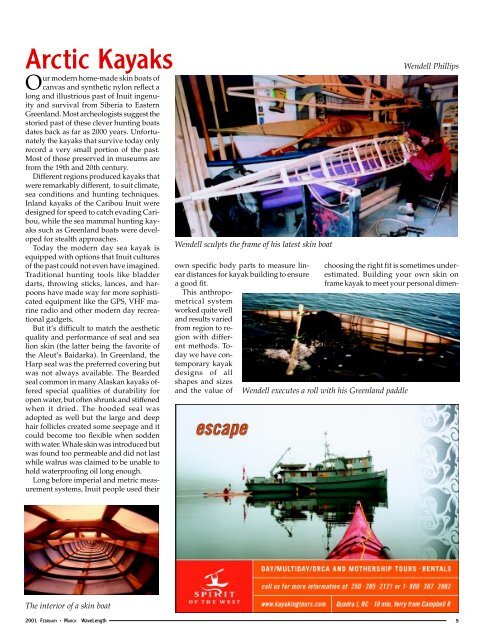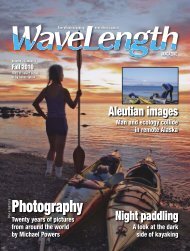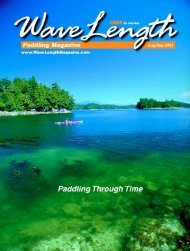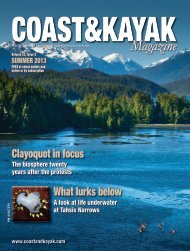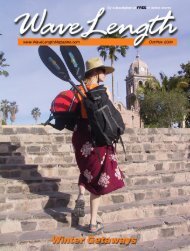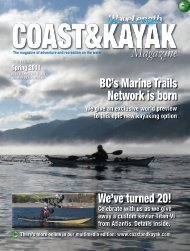Alexandra - Wavelength Paddling Magazine
Alexandra - Wavelength Paddling Magazine
Alexandra - Wavelength Paddling Magazine
You also want an ePaper? Increase the reach of your titles
YUMPU automatically turns print PDFs into web optimized ePapers that Google loves.
Arctic Kayaks<br />
Our modern home-made skin boats of<br />
canvas and synthetic nylon reflect a<br />
long and illustrious past of Inuit ingenuity<br />
and survival from Siberia to Eastern<br />
Greenland. Most archeologists suggest the<br />
storied past of these clever hunting boats<br />
dates back as far as 2000 years. Unfortunately<br />
the kayaks that survive today only<br />
record a very small portion of the past.<br />
Most of those preserved in museums are<br />
from the 19th and 20th century.<br />
Different regions produced kayaks that<br />
were remarkably different, to suit climate,<br />
sea conditions and hunting techniques.<br />
Inland kayaks of the Caribou Inuit were<br />
designed for speed to catch evading Caribou,<br />
while the sea mammal hunting kayaks<br />
such as Greenland boats were developed<br />
for stealth approaches.<br />
Today the modern day sea kayak is<br />
equipped with options that Inuit cultures<br />
of the past could not even have imagined.<br />
Traditional hunting tools like bladder<br />
darts, throwing sticks, lances, and harpoons<br />
have made way for more sophisticated<br />
equipment like the GPS, VHF marine<br />
radio and other modern day recreational<br />
gadgets.<br />
But it’s difficult to match the aesthetic<br />
quality and performance of seal and sea<br />
lion skin (the latter being the favorite of<br />
the Aleut’s Baidarka). In Greenland, the<br />
Harp seal was the preferred covering but<br />
was not always available. The Bearded<br />
seal common in many Alaskan kayaks offered<br />
special qualities of durability for<br />
open water, but often shrunk and stiffened<br />
when it dried. The hooded seal was<br />
adopted as well but the large and deep<br />
hair follicles created some seepage and it<br />
could become too flexible when sodden<br />
with water. Whale skin was introduced but<br />
was found too permeable and did not last<br />
while walrus was claimed to be unable to<br />
hold waterproofing oil long enough.<br />
Long before imperial and metric measurement<br />
systems, Inuit people used their<br />
The interior of a skin boat<br />
2001 FEBRUARY • MARCH WaveLength<br />
Wendell sculpts the frame of his latest skin boat<br />
own specific body parts to measure linear<br />
distances for kayak building to ensure<br />
a good fit.<br />
This anthropometrical<br />
system<br />
worked quite well<br />
and results varied<br />
from region to region<br />
with different<br />
methods. Today<br />
we have contemporary<br />
kayak<br />
designs of all<br />
shapes and sizes<br />
and the value of<br />
Wendell Phillips<br />
choosing the right fit is sometimes underestimated.<br />
Building your own skin on<br />
frame kayak to meet your personal dimen-<br />
Wendell executes a roll with his Greenland paddle<br />
9


